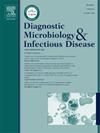Time to positivity for differentiating blood culture contamination: A 20-hour cutoff for major contaminants
IF 1.8
4区 医学
Q3 INFECTIOUS DISEASES
Diagnostic microbiology and infectious disease
Pub Date : 2025-08-05
DOI:10.1016/j.diagmicrobio.2025.117030
引用次数: 0
Abstract
Background
Blood culture remains the gold standard for diagnosing bacteremia; however, contamination inevitably occurs in 2-3% of cases, requiring differentiation between true bacteremia and contamination. Although time to positivity (TTP) aids in this clinical decision, with detection after 24 hours generally indicating contamination, technological advances in blood culture systems may have shortened this threshold interval.
Methods
This study retrospectively analyzed blood culture data in our hospital from April 2023 to January 2025 to determine the optimal TTP cutoff. Patients with positive blood cultures for major contaminating bacteria were included. Cases were classified as true bacteremia or contamination based on a comprehensive chart review conducted by the antimicrobial stewardship audit, and TTP was compared between the groups. Sensitivity, specificity, and Youden index at various TTP cutoffs were utilized to determine the optimal threshold using the receiver operating characteristic curve analysis.
Results
Seventy-one patients were enrolled, with 34 cases classified as true bacteremia and 37 as contamination. Identified bacteria included coagulase-negative staphylococci (70.4%), viridans group streptococci (18.3%), and others (11.3%). The median TTP was significantly shorter in the true bacteremia group compared with the contamination group (18.6 vs.25.8 hours, p < 0.001). In the contamination group, 43.2% of the cases demonstrated positive growth within 24 hours. Based on sensitivity, specificity, and Youden index, the optimal threshold was estimated to be 20 hours. A subgroup analysis of the CNS-only cohort yielded concordant results.
Conclusion
This study suggests that a 20-hour TTP threshold could help effectively differentiate true bacteremia from contamination in current clinical settings.
鉴别血培养污染的阳性时间:主要污染物的20小时临界值
血培养仍然是诊断菌血症的金标准;然而,污染不可避免地发生在2-3%的病例中,需要区分真正的菌血症和污染。虽然到达阳性的时间(TTP)有助于临床决策,24小时后检测通常表明污染,但血液培养系统的技术进步可能缩短了这一阈值间隔。方法回顾性分析我院2023年4月至2025年1月血培养数据,确定最佳TTP截止时间。包括主要污染细菌血培养阳性的患者。根据抗菌药物管理审核进行的综合图表审查,将病例分类为真正的菌血症或污染,并比较两组之间的TTP。利用不同TTP截止点的敏感性、特异性和约登指数,利用受试者工作特征曲线分析确定最佳阈值。结果共纳入71例患者,其中真菌血症34例,污染37例。检出的细菌包括凝固酶阴性葡萄球菌(70.4%)、翠绿菌群链球菌(18.3%)和其他(11.3%)。与污染组相比,真菌血症组的中位TTP显著缩短(18.6 vs 25.8小时,p <;0.001)。在污染组中,43.2%的病例在24小时内呈阳性增长。根据敏感性、特异性和约登指数,估计最佳阈值为20小时。仅cns队列的亚组分析得出了一致的结果。结论:本研究表明,在当前的临床环境中,20小时TTP阈值可以有效地区分真正的菌血症和污染。
本文章由计算机程序翻译,如有差异,请以英文原文为准。
求助全文
约1分钟内获得全文
求助全文
来源期刊
CiteScore
5.30
自引率
3.40%
发文量
149
审稿时长
56 days
期刊介绍:
Diagnostic Microbiology and Infectious Disease keeps you informed of the latest developments in clinical microbiology and the diagnosis and treatment of infectious diseases. Packed with rigorously peer-reviewed articles and studies in bacteriology, immunology, immunoserology, infectious diseases, mycology, parasitology, and virology, the journal examines new procedures, unusual cases, controversial issues, and important new literature. Diagnostic Microbiology and Infectious Disease distinguished independent editorial board, consisting of experts from many medical specialties, ensures you extensive and authoritative coverage.

 求助内容:
求助内容: 应助结果提醒方式:
应助结果提醒方式:


